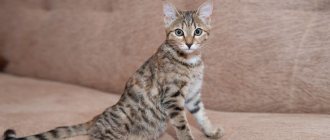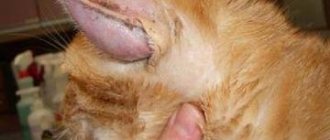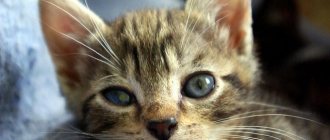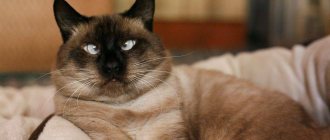Entropion of the eyelids in cats is very common in the practice of a veterinary ophthalmologist and is the most common problem among eye diseases in cats.
Entropion in cats or entropion is an abnormal position of the eyelids relative to the eye and may include inversion of the upper and lower eyelids, medial entropion, or both eyes at the same time.
In this case, the eyelids are shifted towards the eye and the cilia located on the eyelid severely injure the cornea and can lead to inflammation and injury.
Rolled eyelids in a cat
Why does the eyelid curl up?
In cats, entropion of the eyelids occurs for various reasons. The disease is caused by various factors, the main one of which is a genetic predisposition that causes a violation in the structure, as a result of which the eyelid curls up. This eye disease can occur in pets of any breed, but it most often affects the exotic Sphynx, as well as British and Persian cats.
© shutterstock
A cat's eyelids may droop for the following reasons::
- Spasm of the muscles of the orbit of the eye - from such an effect the eyelid experiences inversion;
- Incorrect development of the eyelids, as a congenital defect, when their length is excessive;
- An eye injury in which entropion occurs mechanically. Often injury occurs during play or a fight with another cat or dog;
- Foreign body in the eye - volvulus occurs due to mechanical damage;
- Scar formation - usually this phenomenon occurs if the cat's eyelid has been thermally or chemically burned and its edge is injured. When the damage heals, a scar appears, which causes volvulus;
- Previous unsuccessful surgical manipulations in the eye area, in which the cat did not undergo proper restorative therapy - the structure of the eyelid is disrupted and entropion occurs;
- Paralysis of the facial nerve - against the background of this pathology, the cat loses the ability to control the muscles of the eyelids, and they droop or roll up;
- Age-related degenerative processes in muscles and skin cause, among other things, entropion of the eyelid;
- Neoplasms in the eyelid area of a malignant or benign nature - with such a disease, the eyelid changes (to varying degrees) its shape, which can provoke volvulus.
The upper eyelid inversion is experienced much less frequently than the lower one. The disease has primary and secondary forms. The primary one appears in kittens due to improper development of the eyelids, and the secondary one appears in adult animals against the background of provoking factors associated with muscle dysfunction or injuries.
Functions of the membrane
A cat has a thin, almost transparent film in its eye, which is located in the inner corner. It is called the nictitating membrane. It moisturizes the cornea, serves as a barrier to foreign bodies and microparticles, and also rids the eye of small insects, sand and household dust. This membrane is covered with lymphoid tissue, attached to the inside of the lower and upper eyelids and floats slightly onto the cornea.
We suggest you read: What to do if your cat has dandruff: seborrhea in cats photo
This membrane involuntarily expands and folds, this is noticeable during blinking and when the pet lowers its head. If the eye is irritated, the film swells and increases in size. The membrane lubricates the cornea with a special tear fluid, which protects the eye from bacterial environments and fungal infections.
Manifestations of the disease
If the owner knows the symptoms of the disease, then he will be able to identify bloat in the cat and provide timely assistance to the pet. First of all, when the eyelid rolls up, irritation of the cornea of the eye begins. Entropion of the eyelids is accompanied by other noticeable symptoms. Manifestations of the disease are presented in increasing order as it progresses :
- redness of the eyes;
- profuse lacrimation;
- swelling of the cornea of the eye;
- external reduction in eye size;
- change in the shape of the palpebral fissure due to the fact that the eyelid has rolled up;
- constant moisture in the fur around the eye;
- formation of a purulent mass in the corner of the eye;
- corneal ulcer;
- perforation of the eye.
At the last stage of the disease, a rolled eyelid causes such serious and irreversible changes in the cat's eye that it is impossible to save it. If you return the eyelid to the correct position in time, the problem will be completely eliminated.
© shutterstock
Symptoms
Symptoms vary depending on the stage of the entropion. In the initial stages, blinking becomes more frequent, and there may be a fear of bright light caused by painful sensations. The cat often looks for a place in dark places and turns away its face. In most cases, intense lacrimation begins.
As volvulus progresses, the pain syndrome worsens, and tears may become viscous and cloudy. It often appears that a cat is cross-eyed with one or both eyes. The eyelids look hyperemic, red, the skin around them swells and becomes hot. The process can be complicated by the addition of a bacterial infection, which causes the production of pus. Sometimes an increase in body temperature develops.
As the discomfort increases, the cat may actively rub its eyes with its paw and constantly wash its face. Sometimes this causes additional injury to the cornea and worsens keratitis. Transition to a chronic form threatens complete loss of vision.
Diagnostics
The disease can be determined by a careful external examination. The animal's eyelid itself is directly noticeable, as well as swelling of the eye and purulent discharge.
Before surgical treatment, a complete examination is necessary. For this purpose, the animal is prescribed
- general blood analysis;
- biochemistry;
- Ultrasound of internal organs;
- Analysis of urine;
- ECG.
If all indicators are normal, then the cat will easily tolerate standard anesthesia, and the risk of complications will be minimal.
When a corneal ulcer occurs, after instillation of a fluorescent substance, the eye is examined using a slit lamp. If an infection of the eye is suspected, bacterial culture of the mucus and pus discharge on a nutrient medium is necessary to identify the pathogen and select antibiotics to which it is not resistant.
How to perform cat eye treatments at home
Treatment of eye diseases in cats is carried out at home, following the veterinarian’s instructions:
- Limit the cat's mobility by swaddling it with a towel.
- Rinse your eyes to clean them using special products, for example, Beaphar Oftal or furatsilin solution.
- If drops are used (Tsiprovet, Levometsetin, Floxal), turn the cat's head up, gently pull the lower eyelid down and drop the drops into the resulting pocket between the eyelid and the eyeball.
- If you use a gel or ointment, place it behind the lower eyelid with your index finger and massage the closed eye to distribute the drug evenly. You should not apply the ointment directly from the tube, since sudden movement of the cat may cause eye injury. Hands must first be washed and treated with an aqueous solution of chlorhexidine.
- Use an Elizabethan collar after applying drops and ointments, as the cat will scratch its eyes with its paw due to the burning or tingling sensation caused by the medication.
Treatment
The disease necessarily requires surgical intervention if it is not prohibited due to the general condition of the animal. If a sore eyelid is left untreated, the cat will not only go blind, but also lose an eye.
During therapy, one of two types of surgery can be performed. The first is the application of a temporary suture, and the second is eyelid surgery. The veterinarian will choose what kind of intervention the animal needs.
The first method is used in cats up to 7 months, when correction is possible due to the growth of the animal. To return the eyelid to a safe position, its lower edge is connected to the skin under the eye with a special mattress suture. The manipulation is simple and does not require anesthesia, which makes it much easier for the pet to tolerate.
© shutterstock
If the cat is older than 7 months, then the pathology can only be eliminated with eyelid surgery. This operation is performed under general anesthesia. During the intervention, a piece of excess skin is cut off, which is why the eyelid is curled inside the eye. The edges of the wound are then sutured, which returns the eyelids to their natural state.
Both types of surgery are performed only in the clinic.
Operation of entropion of the eyelids of cats - consequences and prognosis
General anesthesia, under which the intervention is performed, is well tolerated by animals. 90% of operations take place without complications; in the remaining 10% of cases, improper postoperative care plays a key role in the development of complications. The operation of turning the eyelids of cats, as a result of which fixing sutures are applied, can be complicated by their suppuration.
To prevent pathology, regular treatment of sutures is necessary. A plastic collar is placed around the cat's neck to prevent scratching. For 5-7 days, it is necessary to use antibiotics in drop form and wash the sutures with antiseptic solutions. During the normal course of the postoperative period, the sutures are removed after 8-12 days.
We suggest you read: Paraanal sinusitis in a cat Just about the complex
In our clinic, a doctor is an ophthalmologist, a doctor of the highest category, Kopenkin A. E.
In most cases, the prognosis for the animal is favorable. Usually the percentage of successful outcomes reaches 90-95%. But the success of the operation is influenced by many factors:
- The pet's health status before surgery.
- Age of the cat.
- Cat breed.
- Does the pet suffer from secondary pathologies?
After the operation, the pet needs careful care. A special bandage is put on it, which prevents it from scratching. In some cases, the use of additional medications is required.
If you do not take care of your pet and allow it to injure the newly operated eye, problems will most likely begin. But if you carefully monitor the cat’s condition, the outcome will definitely be successful. If any problems arise, you should definitely contact your veterinarian.
The cat will also need regular treatment of the stitches with a special solution prescribed by the veterinarian. It's easy; they'll show you how to do it right from the start. With proper care and successful rehabilitation, the sutures are removed 8-10 days after the operation, and the cat can lead a full life without restrictions.
Thus, entropion of the eyelid in a cat is a fairly common problem. Don't be afraid that surgery is required to solve it. This is a simple operation, but without it the pet’s condition will deteriorate sharply, which will ultimately lead to loss of vision.
In the vast majority of cases, the prognosis for cats is quite favorable. However, several factors influence a successful outcome: the animal’s age, breed, tendency to relapse, and general health. Careful care after surgery is essential. To prevent scratching of the wound, the cat is given a special collar.
If the animal scratches its eyes, the problem may recur, and then you will have to go to the clinic again. Sutures should be regularly treated with special solutions prescribed by the attending physician. With proper care and successful healing, the sutures can be removed 10 days after the operation, and the cat will begin its full life again.
Thus, we can conclude that entropion of the eyelid in a cat is a completely solvable problem that can be easily treated, without which the condition of your beloved pet can greatly worsen, as a result of which he can completely lose his vision. Therefore, you should not delay with this problem, but immediately contact a veterinary clinic.
Causes
What are the causes of blepharitis in cats? What causes eye pain?
- Pathogenic microorganisms. Viruses and bacteria. Of the bacteria, the most common cause of blepharitis in cats is pyogenic cocci (staphyllo and strepto).
- Parasites, in particular subcutaneous mites (diseases called demodicosis, sarcoptic mange). Only the eyelids are affected, but also the face and neck.
- Fungi. Most often these are pathogens of trichosporia and microsporia (lichen).
- Allergy. It can be for food, medicine, dust, plants, or anything. There are thousands of allergens in nature!
- Trauma to the eye, usually a wound (for example, after a fight or self-scratching).
- Seborrhea. When the functioning of the sebaceous glands is disrupted, not only does the pet become covered in dandruff, but scales also appear on the eyelids.
- Salivary gland duct transplantation.
Blepharitis
Blepharitis is a group of eye diseases. Blepharitis manifests itself as inflammation of the edges of the eyelids. The disease is characterized by a chronic course.
Blepharitis is not a serious disease, but treatment requires an integrated approach.
There may be various reasons:
- autoimmune diseases,
- allergy,
- disruption of the endocrine system or sebaceous glands,
- pathogenic microorganisms,
- mechanical injury,
- parasitic infestation (infection of a cat with parasitic worms).
There are several forms of blepharitis:
- Meibomian. Characterized by the formation of formations on the edge of the eyelid. A high level of secretion is observed.
- Ulcerative blepharitis. It occurs with the formation of yellowish crusts. This disease is often caused by a chronic infection. Various symptoms may occur (fatigue, photosensitivity, watery eyes, etc.).
- Scaly blepharitis. This form is characterized by the following symptoms: thickening of the edge of the eyelids, redness. Scaly blepharitis is often caused by Staphylococcus aureus.
Treatment is carried out under the supervision of a qualified veterinarian.
After eliminating the cause, complex treatment is prescribed:
- course of immunoglobulins,
- course of antibiotics,
- antibacterial emulsions and suspensions.











